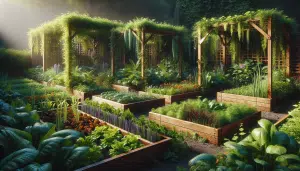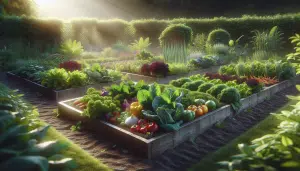You Can Transform Your Outdoor Space With Raised Garden Beds
Lily Carter September 22, 2025
Unlock the secrets of creating a thriving home garden with raised garden beds. Discover how to design, build, and maintain an inviting green space that suits your needs, supports healthy plants, and brings more joy to your everyday living. Explore essential tips for construction, soil selection, and plant choices in this practical raised beds guide.
Why Raised Garden Beds Appeal to Homeowners
Raised garden beds have emerged as a favorite among gardening enthusiasts looking to maximize yield, minimize labor, and achieve a visually pleasing landscape. Homeowners are drawn to the clean look that well-designed garden beds provide and appreciate how they bring order to outdoor spaces. Elevating plants above ground level offers many other advantages, such as improved drainage and easier weed control, making the gardening process more straightforward and enjoyable. Clear boundaries provided by beds keep lawns and walkways tidy, and raised beds can add a modern twist or charming rustic appeal, depending on the style you select for your landscape. They suit nearly any size or shape of yard, from tiny patios to sprawling lawns, which has only boosted their popularity in recent seasons.
One key advantage of using raised garden beds is greater control over the soil environment. With in-ground gardens, soil compaction, drainage issues, and poor fertility can hinder healthy plant growth. Raised structures are typically filled with a custom blend of compost, topsoil, and organic matter, allowing you to craft ideal conditions for everything from vegetables to flowers. This means fewer worries about contaminated or unsuitable soil, which is especially important in urban areas where native soil can be less than optimal for home gardening (Source: https://extension.psu.edu/raised-bed-gardening).
Another benefit is accessibility. Many people find stooping and kneeling for extended periods difficult, particularly those with mobility issues or older adults who still love to garden. Raised beds offer a more ergonomic working height, reducing strain and making it possible to enjoy planting and harvesting with less effort. That accessibility fosters a sense of accomplishment and invites more people into the world of home gardening. It also helps keep pets and children from accidentally trampling delicate seedlings or maturing crops.
Design Considerations for Raised Beds in Home Gardens
Thoughtful planning helps transform the initial vision for raised beds into a functional and visually harmonious garden. The first step involves deciding on the dimensions and placement of beds. Most raised beds are built 4 feet wide or less, allowing for easy access from each side without stepping onto the soil. Length and height can vary, but a depth of 12 to 18 inches is suitable for most plants. Selection of location should prioritize sunlight exposure—many vegetables and ornamentals thrive with at least six hours of sunlight per day (Source: https://hgic.clemson.edu/factsheet/raised-bed-gardening/).
Do not overlook materials when constructing a raised bed. Wood is a popular choice due to its availability, ease of use, and classic appearance. Cedar and redwood are naturally rot-resistant and suitable for organic gardening. Composite wood, stone, recycled plastic lumber, and even metal are other viable materials, each with its unique advantages. The chosen materials should be free of chemicals that could leach into the soil and affect plant health. Durability and climate compatibility also play a part; for example, untreated pine may deteriorate quickly in humid areas (Source: https://www.gardeningknowhow.com/edible/vegetables/vgen/using-wood-raised-beds.htm).
Incorporating walkways between beds is highly recommended for convenience and safety. Walkways of at least 18 inches wide are sufficient for most gardeners and wheelbarrows. Mulched, paved, or gravel paths prevent muddy shoes and support year-round gardening activity. Additional customizations, such as trellises or shade covers, can be built into raised bed designs to accommodate vining plants or hot climates. Planning irrigation solutions from the start—such as soaker hoses or drip systems—offers a way to conserve water and ensure consistent plant health.
Soil and Compost: The Cornerstone of Healthy Raised Beds
Soil quality is crucial for a thriving raised bed garden. Since you’re filling your beds from scratch or amending existing soils, you have the freedom to mix high-quality materials that boost plant growth and crop productivity. A mixture of topsoil, finished compost, and organic matter such as aged manure forms a foundational blend that supports vigorous root systems and robust nutrient cycling. Adding worm castings or leaf mold can further enhance structure and fertility (Source: https://extension.umn.edu/planting-and-growing-guides/raised-bed-gardens).
Compost not only feeds the soil but also improves water retention—a major benefit for raised bed gardens, which can dry out faster than native soils. Organic compost contains microbes, fungi, and nutrients that help plants ward off diseases and adapt to challenging growing conditions. Over time, a healthy composting practice ensures beds remain fertile without synthetic fertilizers. Some gardeners replenish or top-dress their beds each season to keep building rich, living soil (Source: https://www.cfaes.osu.edu/news/articles/tip-week-improving-your-soil-raised-garden-beds).
Many gardeners also employ mulch to protect bare soil surfaces. Mulching with straw, leaf litter, or shredded bark prevents soil erosion, holds moisture, and limits weed growth. It creates a healthy environment for soil organisms and reduces the maintenance required between growing periods. Strong soil health means plants are more resilient, attractive, and productive throughout the gardening season—a key attribute for low-maintenance, eco-friendly landscaping.
Choosing Plants For Raised Garden Beds
Raised garden beds are remarkably versatile, supporting a broad range of edible crops and ornamental plants. Vegetables like tomatoes, peppers, lettuce, carrots, and herbs often flourish in raised beds due to the controlled soil environment. Root crops, such as carrots and potatoes, benefit from the loose, deep soil, making harvesting easier and resulting in straighter, more uniform produce (Source: https://www.gardeningknowhow.com/garden-how-to/projects/what-to-plant-in-raised-beds.htm).
Seasonal rotation and companion planting can maximize yield and reduce pest problems. Many gardeners use raised beds for intensive planting patterns, spacing crops closer together while still allowing airflow between leaves. Marigolds, nasturtiums, and other flowers add color while also helping to repel unwanted insect pests. Successive plantings allow you to use the same space for early spring greens and late summer beets or beans.
In addition to vegetables and herbs, raised beds are ideal for perennials, berries, and small fruit trees. Strawberries are a frequent favorite, producing reliably in raised beds where soil can be kept slightly acidic and well-drained. Dwarf blueberries and even grapevines can be accommodated with careful soil amendments. Experimenting with plant selection keeps home gardening exciting and opens up fresh opportunities to enjoy the harvest.
Maintaining Healthy Raised Beds Over Time
Long-term success depends on regular bed maintenance. Over time, organic matter in the soil breaks down, causing the level to drop and making periodic refilling with compost or soil necessary. Testing soil for nutrient levels or pH is wise, especially if plants show signs of stress or slow growth. Simple at-home soil tests allow for fine-tuning, ensuring beds stay productive year after year (Source: https://extension.uga.edu/publications/detail.html?number=C1027).
Managing pests and weeds is typically easier in raised beds thanks to the clean boundaries and improved soil. However, vigilance remains important. Use mulch to restrict weed germination and install barriers to keep out small animals if needed. Many gardeners rotate crops each season to prevent the buildup of soil-borne diseases and keep beds healthy without heavy reliance on chemical interventions.
Finally, irrigation should be monitored closely. Raised beds often dry out faster than in-ground beds, especially in warm climates or during hot spells. Soaker hoses and drip systems deliver water precisely, conserving resources while providing adequate moisture to roots. Consider covering beds in the off-season with a winter crop or organic mulch to protect soil structure and enrich it ahead of spring planting.
Creative Uses and Landscape Integration For Raised Beds
Raised beds are not limited to traditional vegetable gardens. They can function as decorative focal points, edible borders, or privacy screens depending on their shape and the plants you select. Grouping multiple beds with varying heights or shapes allows for vertical gardening, maximizing output and visual interest in limited spaces (Source: https://extension.unh.edu/resource/raised-bed-gardening-fact-sheet).
With thoughtful design, garden beds can integrate seamlessly with patios, decks, or other hardscaping elements. Consider incorporating built-in seating, storage benches, or decorative finishes that reflect personal tastes and tie the garden into existing architecture. Many homeowners use raised beds to divide property lines, frame entryways, or add curb appeal to their homes. The possibilities are nearly endless.
Raised beds also support eco-friendly practices like rainwater harvesting, composting, and pollinator habitat creation. Including native plants in the bed design supports local wildlife while reducing maintenance. Small, manageable spaces provided by raised beds are ideal for experimenting with sustainable methods—such as organic mulching or integrated pest management—giving homeowners both control and confidence in their gardens.
References
1. Penn State Extension. (n.d.). Raised Bed Gardening. Retrieved from https://extension.psu.edu/raised-bed-gardening
2. Clemson Cooperative Extension. (n.d.). Raised Bed Gardening. Retrieved from https://hgic.clemson.edu/factsheet/raised-bed-gardening/
3. University of Minnesota Extension. (n.d.). Raised bed gardens. Retrieved from https://extension.umn.edu/planting-and-growing-guides/raised-bed-gardens
4. The Ohio State University. (2022). Tip of the Week: Improving your soil for raised garden beds. Retrieved from https://www.cfaes.osu.edu/news/articles/tip-week-improving-your-soil-raised-garden-beds
5. University of Georgia Extension. (n.d.). Raised Bed Materials. Retrieved from https://extension.uga.edu/publications/detail.html?number=C1027
6. University of New Hampshire Extension. (n.d.). Raised Bed Gardening. Retrieved from https://extension.unh.edu/resource/raised-bed-gardening-fact-sheet







